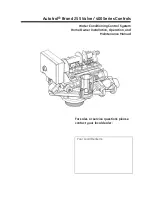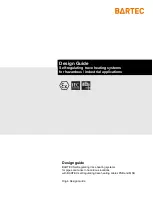
34
Delinquency Code:
The
Delinquency
reporting code is
sent whenever the panel is not armed within the number
of days programmed for the Delinquency Transmission
Delay.
General Zone Low Battery Alarm:
the panel will trans-
mit a
General Zone Low Battery Alarm
reporting code
when a wireless detector indicates a low battery condition
and the delay programmed in Zone Low Battery Trans-
mission Delay expires.
General Zone Low Battery Restoral:
the General Zone
Low Battery Restoral reporting code will be transmitted
when the low battery condition on all wireless zones is
corrected. The specific zone that caused the trouble will
be stored to the event buffer.
Installer Lead In:
a reporting code will be sent to the cen-
tral monitoring station when Installer Programming is
entered through the keypad.
Installer Lead Out:
a reporting code will be sent to the
central monitoring station when Installers programming
is exited.
[348] - Test Transmission Reporting Codes
Walk Test End:
the
Walk Test End
reporting code will be
transmitted when a Walk Test is terminated.
Walk Test Begin:
the
Walk Test Begin
reporting code will
be transmitted when a Walk Test is initiated.
Periodic Test Transmission with Trouble
- the panel can
be programmed to transmit a
Periodic Test Transmission
with Trouble reporting code in place of the standard Peri-
odic Test Transmission if any of the following conditions
exist.
• Fire Zone Trouble (Zones 1-64)
• Battery Trouble (PC5020, PC520X)
• Fire Zone Alarm (Zones 1-64, Two-Wire Smoke
• Aux Trouble (PC5020)
• Fire Trouble (2-wire Smoke)
• Bell Trouble (PC5020)
• Fire Tamper/Low Sensitivity (Wireless/AML Zones 1-32)
• Module Supervisory
• Fire Zones Bypassed (Zones 1-64)
• Ground Fault (PC5700)
• Fire Supervisory (Wireless/AML Zones 1-32)
• TLM Trouble (PC5020, PC5700 Line 1-2)
• AC Trouble (PC5020, PC520X)
• FTC Trouble
Periodic Test Transmission:
the Periodic Test Transmission
reporting code will be transmitted at the specified time,
(programmed in Section 378) every X number of days (see
Section 377).
System Test:
the System Test reporting code will be trans-
mitted when a system test is performed on the panel.
Links 1000 Test Transmission Code:
the Links1000 Test
Transmission reporting code will be transmitted via the
LINKS1000 cellular transmitter at the programmed inter-
val (see ‘Test Transmission Cycles’ section [378]) and time
of day (see Section [377]) of the LINKS Periodic Test
Transmission.
NOTE:
To disable this transmission of this reporting code, 00
must be entered.
[349] - PC5700 Maintenance Reporting Codes
PC5700 Ground Fault Trouble:
the panel will transmit this
reporting code when a Ground Fault Trouble occurs on
the PC5700.
PC5700 Ground Fault Restoral:
the panel will transmit
this reporting code when the Ground Fault Trouble condi-
tion has restored on the PC5700.
PC5700 TLM 1(2) Trouble:
the panel will transmit this
reporting code when a TLM Trouble occurs on the
PC5700 line 1 and/or on line 2.
PC5700 TLM 1(2) Restoral:
the panel will transmit this
reporting code when a TLM Restoral occurs on the
PC5700 line 1 and/or line 2.
[350] - Communicator Format Options
Communicator - Reporting Formats
Each central station telephone number of the panel can be
programmed to report using any one of the 5 formats
available. The following formats are supported: Pulse (10
and 20 bps), Contact ID, SIA, Residential Dial and a Pager
format. The following is a description of each.
SIA (Level 2)
SIA is a specialized format that will communicate infor-
mation quickly using frequency shift keying (FSK) rather
than pulses. The SIA format will automatically generate
the type of signal being transmitted, such as Burglary,
Fire, Panic etc. The two digit reporting code is used to
identify the zone or access code number.
NOTE:
SIA format must be used if Downlook is
required.
NOTE:
SIA format must be used for phone numbers
programmed to communicate via the T-Link.
If the SIA format is selected the panel can be programmed
to automatically generate all zone and access code num-
bers eliminating the need to program these items.
If the
SIA Sends Automatic Reporting Codes
option is
enabled the panel will operate as follows:
1. If the reporting code for an event is programmed as [00]
the panel will not attempt to call the central station.
2. If the reporting code for an event is programmed as any-
thing from [01] to [FF] the panel will AUTOMATICALLY
generate the zone or access code number.
3. Bypassed zones will always be identified when partial
closing of the system occurs.
The Communicator Call Direction Options can be used to
disable reporting of events such as Openings/Closings.
Also, if all the Opening/Closing reporting codes were
programmed as [00] the panel would not report.
If the
SIA Sends Automatic Reporting Codes
option is
disabled the panel will operate as follows:
1. If the reporting code for an event is programmed as [00] or
[FF] the panel will not attempt to call the central station.
2. If the reporting code for an event is programmed as any-
thing from [01] to [FE] the panel will send the programmed
reporting code.
3. Bypassed zones will not be identified when partial closing
the system.
NOTE:
If using Downlook, do not program the second
telephone number for the SIA reporting code format
(Section [360]) if the Automatic Reporting Code option
is enabled (Section [381]).
NOTE:
The zone number for Zone Low Battery and
Zone Fault events will not be identified when Pro-
grammed SIA is used.
SIA Sends Automatic Reporting Codes . . .Section [381], Option [3]
Communicator Call Direction Options . . . . . . Section [351] to [376]
SIA Identifiers . . . . . . . . . . . . . . . . . . . . . . . . . . . . . . . Appendix A
Residential Dial
If Residential Dial is programmed and an event pro-
grammed to communicate occurs, the panel will seize the
line and dial the appropriate telephone number(s). Once
the dialing is complete, the panel will emit an ID tone and
wait for a handshake (press a 1, 2, 4, 5, 7, 8, 0,
✱
or # key
Summary of Contents for PC5020 Power864
Page 67: ...NOTES ...
















































